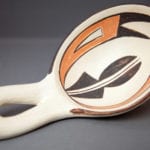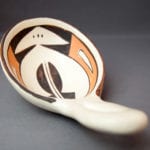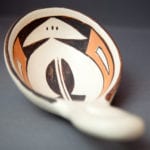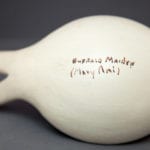Although this ladle was made for the tourist market, its shape is the same as those traditionally made for home use (2008-15a). The bowl and handle are evenly-formed but thick, giving the ladle substantial heft. The shape is graceful and when held in the hands with eyes closed, sensuous. The smooth white kaolin slip is flawless, hiding the color of the clay body.
A black line encircles the top rim of the bowl, but is interrupted by the handle. The viewer’s eyes are thus encouraged to sweep from the decorated bowl to the plain handle, uniting the two sections of this form. The design on the bowl is symmetrical, consisting of a black central element flanked by two identical polychromatic bands of design.
The central element is split with a single line in the center, forming a two-lane “highway.” The same motifs flank this line: a triangular element is surmounted by a half-moon lunette. The linear sides of the triangle create a visual tension with the rounded line of the lunette, energizing this simple design.
An avian design flanks this central element and is repeated reflectively on either side of the bowl. Elongated red beak elements with triangular eyes dominate the design. The beaks barely touch, but create an energy that pulls the overall design towards the handle. From the rear of the red beaks, two black triangles form short tails, the points of the outer set just touching. These tails frame a roughly triangular unpainted space, in which Mary Ami has painted three black dots.
All of the elements in the design are common on Hopi pottery, but their configuration within the bowl of the ladle results in an unusual pattern. Lydia Wyckoff (1985:100) discusses a design pattern called “figure-ground reversal” or “negative design” where “when you look at (a) pot, the figure and the background against which it is placed keep changing places, the figure becoming the background and the background becoming the figure.”
Refocus your eyes on the ladle design, and the unpainted areas become a figure with an oval body, a triangular head with three eyes and thin, triangular arms.
What at first seems like a rather simple design thus has a complicated impact on a viewer. The oversize red beaks thrusting toward the handle energize the design; the figure emerging from the unpainted areas by figure-ground reversal further unsettles the viewer.
Mary was born in 1919 and her mother “Dalee” was Grace Chapella’s sister. Pottery by Dalee is almost unknown, though I have an example in this collection (2011-20). Dalee died when Mary was only 2 years old and she was adopted by Grace and presumably learned pottery making from her. (CLICK HERE to view pots by Grace.)
Pottery by Mary Ami is not common. I have only seen one other piece for sale and added it to the collection (2001-01). Schaaf (1998:31) indicates that Mary produced pottery from 1940 to 1980. Since most Hopi pottery was not signed until the late 1970’s, I am guessing that this ladle was probably made during the last ten years of her pottery career.
The two Mary Ami pots in this collection have identical heft, white kaolin finish, paint density and color. Both pots are evidence that Mary was an exceptional potter. On both pots the line work is even, clean and confident.








